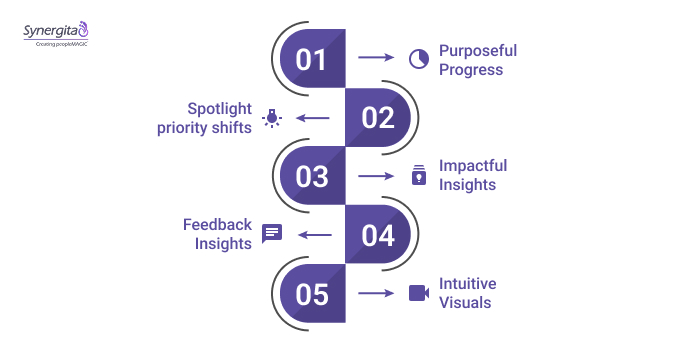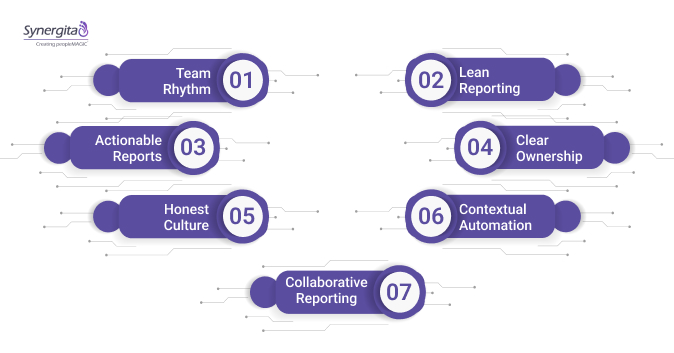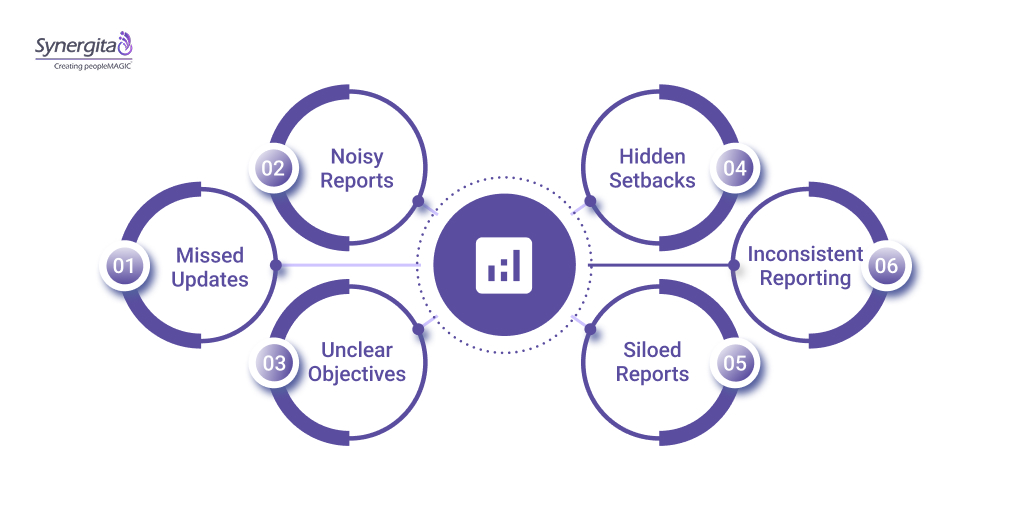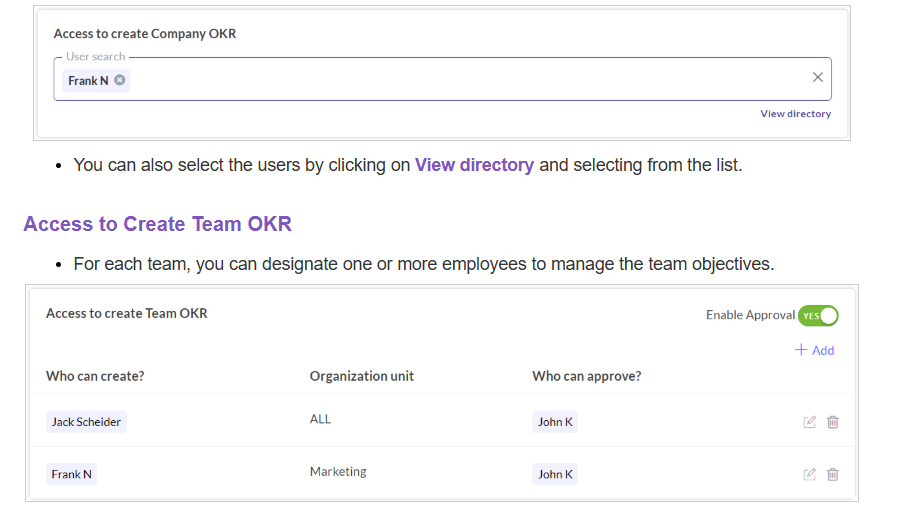Setting OKRs is only half the job. Without consistent reporting, even the best objectives risk fading into the background. Reporting is what keeps OKRs alive throughout the quarter. It helps teams stay aligned, surface blockers early, and turn goals into outcomes that matter.
In fact, “83 percent of companies working with OKRs believe they have benefited from implementing the framework.” The reason? Regular updates and clear reporting habits that connect everyday work with top-level goals.
As organizations grow more agile and cross-functional, reporting becomes the thread that ties strategy to execution. In this blog, we will break down what OKR reporting really involves, why it is critical in 2025, and which practices can make your OKR process more effective, transparent, and scalable.
Key Takeaways:
- OKR reporting keeps teams focused and ensures goals stay relevant throughout the quarter
- Reports should highlight progress, explain blockers, and guide decision-making
- Regular check-ins build accountability and surface issues early
- Visual summaries and structured formats make reports easier to consume
- Automation and integrations help reduce reporting fatigue and improve consistency
- Clear ownership and honest updates are key to sustaining effective OKR reporting
What Is OKR Reporting and How It Works
OKR reporting is the structured process of tracking and communicating progress on objectives and their key results. It helps leaders and teams stay updated on what is moving forward, what is falling behind, and where attention is needed. Unlike casual status updates or generic goal tracking, OKR reporting ties every update directly to strategic objectives.
An effective OKR report typically includes a mix of the following:
- Progress summaries for team and company-level OKRs
- Updates on individual key results with measurable outcomes
- Comments or context explaining changes, delays, or blockers
- Visual indicators like progress bars or traffic light signals
- Lessons learned and action items discussed in check-ins or reviews
Most companies run weekly or biweekly check-ins and wrap up the OKR cycle with a detailed retrospective or performance review. This rhythm helps reinforce accountability and builds a feedback loop for improving goal-setting in the next cycle.
Reporting is not just about keeping leadership informed. It ensures everyone understands how their work connects to broader business goals. That visibility creates alignment, reduces silos, and allows teams to adjust their focus in real time.
Why OKR Reporting Matters for Growing Teams
As companies scale, so do their challenges; more people, more projects, and more room for misalignment. Without a clear way to report on goals, fast-growing teams often lose track of priorities. OKR reporting fills that gap by turning strategic intent into daily clarity.
For growing teams, reporting is more than just a performance metric. It:
- Keeps cross-functional teams aligned without constant meetings
- Flags misaligned efforts before they become costly distractions
- Helps new hires ramp up faster by showing what matters and why
- Builds trust with leadership through visible, data-backed progress
- Promotes consistency in how goals are tracked across departments
Growth is messy. OKR reporting brings order to that chaos. It ensures that even as teams expand, the focus on outcomes doesn’t get diluted.
Building an OKR Report That Delivers Real Insights

An OKR report should do more than show numbers. It should spark action, reveal trends, and provide clarity for better decision-making. To achieve that, it needs structure, context, and relevance to both teams and leadership.
Here’s what helps elevate an OKR report from routine to insightful:
- Highlight progress with purpose: Show what has moved and why. Don’t just list percentages. Include short narratives that explain the momentum or blockers behind each key result.
- Spotlight priority shifts: If any objectives were paused, re-scoped, or accelerated, document the change and its rationale. This creates a running log of strategic adjustments across the cycle.
- Group insights by impact: Categorize updates as on track, at risk, or off track. This helps teams quickly focus on areas needing attention without scanning through all metrics.
- Capture feedback and learnings: Pull in insights from check-in meetings, stakeholder comments, or lessons learned during execution. These add depth to the numbers and support future goal refinement.
- Make visualisation intuitive: Use progress bars, traffic light indicators, and summary charts to give readers a quick grasp of the situation. Visual clarity reduces reporting fatigue and improves stakeholder engagement.
When built right, an OKR report becomes a living document. It supports agile planning, prompts informed discussions, and ensures that each cycle builds smarter than the last.
OKR Reporting Best Practices to Adopt Now

As OKRs become embedded in daily operations, the quality of reporting often determines how effective the entire framework becomes. Beyond tracking numbers and highlighting issues, great OKR reporting is about building habits and mindsets that drive results at every level. Here are some key practices to elevate your OKR reporting process:
- Create a rhythm teams can stick to: Set a consistent cadence for updates. Whether weekly or biweekly, regularity builds accountability and keeps OKRs top of mind without overwhelming your teams.
- Keep reporting lightweight and focused: Avoid turning updates into admin chores. Use short, structured prompts for check-ins that take less than five minutes to complete but still provide meaningful insights.
- Link reports to real decisions: Tie each report to planning or review moments. When teams know their updates inform priorities, resourcing, or recognition, reporting feels purposeful rather than procedural.
- Define ownership at every level: Ensure each key result has a clear owner responsible for reporting and follow-through. Ownership drives clarity and prevents objectives from falling through the cracks.
- Encourage honesty over perfection: Create a safe space for reporting blockers or setbacks. When teams feel comfortable sharing roadblocks, issues can be resolved early instead of being buried until review time.
- Use automation without removing context: Leverage tools that simplify data collection and reminders but ensure there’s room for narrative context. Numbers alone rarely tell the full story of progress or challenges.
- Integrate reporting into collaboration channels: Connect OKR reporting to where teams already work, such as Slack or Microsoft Teams. Seamless updates boost adoption and reduce friction in fast-moving environments.
Also read: Benefits of Having an OKR Software in Your Organization
Time Saving Techniques of OKR
OKR reporting should support your workflow, not slow it down. When done right, it fits naturally into how your team already operates. These techniques help save time while keeping the reporting process valuable and consistent.
- Start with a repeatable format: Create a reusable report template that outlines what needs to be captured each cycle. A consistent format saves time and reduces confusion during updates.
- Connect your tools for faster data collection: Integrate your OKR platform with tools like project trackers, CRMs, or HR systems. This allows key metrics and status updates to flow in automatically, removing the need for manual input.
- Use short check in prompts: Keep updates simple and focused. Ask team members to share quick progress notes, blockers, and next steps. Structured prompts take less than five minutes to fill but give a complete picture.
- Share the responsibility: Encourage shared ownership by involving multiple team members in the reporting process. It builds engagement and avoids bottlenecks caused by relying on a single owner.
- Make OKR reviews part of existing meetings: Add OKR updates to your weekly standups, retrospectives, or team syncs. By embedding them into regular rituals, reporting becomes second nature rather than a separate task.
- Automate reminders and follow ups: Set up automatic nudges through tools like Slack or Microsoft Teams to remind people when check ins are due. This keeps reporting consistent without needing manual chasing.
- Turn reports into action plans: Use the insights gathered to fuel leadership discussions, sprint planning, or 1:1s. Reusing reports in multiple ways increases their value without adding extra effort.
Must read: 30 Ways to Enhance Employee Productivity and Fuel Growth with OKRs
Common Reporting Pitfalls and How to Fix Them

Even with the best intentions, OKR reporting can go off track. From inconsistent updates to data overload, many teams struggle to keep the process effective over time. Here are the most common pitfalls and practical ways to avoid them.
- Updates are skipped or delayed: When reporting becomes irregular, it loses impact and teams fall out of sync. Fix this by setting a consistent check-in schedule and assigning clear owners for each OKR. A rhythm builds accountability.
- Reports are filled with noise, not insight: Pages of status updates can overwhelm readers without adding clarity. Instead of listing everything, summarise only what moved, what stalled, and why. Visual cues like charts or color-coded indicators help teams scan quickly and focus where it matters.
- Objectives are too vague or overambitious: Reporting fails when the goals themselves lack clarity. Make sure each objective is measurable and realistic. Break large goals into smaller, trackable milestones so that progress feels achievable and easy to report on.
- Teams avoid sharing setbacks: When the environment punishes failure, teams report only wins. This leads to blind spots and missed opportunities. Foster a culture where honest reporting is encouraged and issues are treated as learning moments, not liabilities.
- Reports stay siloed and never drive action: If OKR reports are created but not discussed, they lose purpose. Integrate reporting into decision-making forums like planning meetings or leadership reviews. When reports lead to changes or support, teams see their value and stay invested.
- Different teams use different reporting styles: Lack of standardisation across teams creates confusion. Define a shared reporting format that is flexible enough to adapt but structured enough to compare performance across the company.
Choosing the Right Tools for OKR Reporting
The right tool can turn OKR reporting from a manual chore into a dynamic feedback system that supports real-time visibility, decision-making, and accountability. When evaluating tools, focus on how well they support collaboration, automate data flows, and integrate across your existing systems.
- Prioritise deep integrations: Choose tools that plug into your existing tech stack. Look for compatibility with project management platforms, HR systems, and communication tools. This ensures that updates do not need to be manually transferred between systems and that key metrics are always current.
- Use built-in dashboards and real-time tracking: A good OKR tool makes performance visible at a glance. Look for dashboards that highlight goal progress, flag risks early, and let stakeholders filter by team, owner, or objective. Real-time tracking ensures teams can course-correct before goals go off track.
- Collaborate where work already happens: OKRs should not live in a separate silo. The most effective tools integrate with everyday platforms like Slack, Microsoft Teams, and Notion. This allows updates, nudges, and insights to appear where your team is already communicating, reducing friction and improving adoption.
- Centralise goal data with performance and engagement: Choose platforms that do more than just track OKRs. Tools that connect goals with employee feedback, performance data, and engagement surveys create a richer picture of what drives outcomes. This integration helps leaders identify high-impact contributors, recurring blockers, and team-level trends over time.
- Support flexible reporting styles: Different teams need different levels of detail. Look for tools that allow for structured updates, quick summaries, and in-depth analytics depending on the audience. Whether it’s for a leadership dashboard or a team check-in, flexibility ensures reports are always fit for purpose.
- Scale with your org’s growth: As your company adds new teams and layers of goals, your OKR system should keep pace. Look for tools that support multi-level reporting, role-based access, and cross-functional visibility. A scalable platform ensures clarity even as complexity increases.
The right tool will not just manage OKRs. It will actively shape how your teams collaborate, track progress, and stay accountable to the goals that matter most.
How Synergita Enables Smarter OKR Reporting
OKR reporting becomes more effective when it is embedded into the systems your team already uses to set goals, review progress, and provide feedback. Synergita supports this by offering a unified platform that brings together goal alignment, continuous feedback, and performance tracking in one place.
- Align goals across levels: Synergita allows objectives to be set at the individual, team, and organizational levels. This makes it easier to connect day-to-day tasks with broader company priorities and maintain visibility across functions.
- Monitor progress in real time: Through visual dashboards and progress indicators, Synergita helps teams see what is advancing and what needs attention. This makes it easier to track performance trends without relying on separate spreadsheets or manual reports.
- Automate regular updates: Synergita allows you to schedule recurring check-ins so that updates happen consistently. Automated prompts remind team members to reflect on their progress, share blockers, and provide context behind the numbers.
- Include context, not just metrics: Along with numerical updates, Synergita supports narrative comments and feedback. This adds clarity to each update and helps teams understand the story behind the data.
- Enable visibility across teams: Role-based access ensures that relevant stakeholders can view and collaborate on OKR progress without causing duplication or confusion. Everyone stays informed and aligned.

When OKRs and reporting are connected to performance and feedback, the process becomes more meaningful and easier to sustain. Synergita provides that foundation without disrupting how your teams already work.
Curious how it would look in your environment? Book a demo to explore how Synergita can support your OKR reporting process from planning through review.
Wrapping Up
Good OKRs set direction. Great reporting makes sure you stay on course. The difference lies in how clearly you surface progress, how early you catch blockers, and how well you connect daily work to business goals. With a consistent rhythm and the right tools, OKR reporting becomes less of a task and more of a strategic habit.
If you’re looking to make OKR tracking easier and more meaningful, Synergita offers a structured way to align updates, performance, and priorities without complicating your process.
Want to see how it works? Book a demo!
Frequently Asked Questions
Q: What is an OKR report?
A: An OKR report is a structured summary that tracks progress on objectives and their key results. It helps teams stay aligned, identify blockers, and adjust focus by showing how goals are moving forward or where they are falling behind. These reports often include progress summaries, measurable outcomes, visual indicators, and key takeaways from review discussions.
Q: What is an OKR vs a KPI?
A: OKRs are a goal-setting framework that outlines what you want to achieve and how you will measure progress. KPIs are individual performance indicators that track specific metrics. While KPIs focus on outcomes, OKRs combine ambition with measurable steps to drive strategic progress. Think of KPIs as the metrics and OKRs as the strategic framework that gives those metrics context.
Q: What is an OKR example?
A: A simple OKR example could be:
- Objective – Improve customer support experience
- Key Result 1 – Reduce average first response time to under 2 hours
- Key Result 2 – Achieve a customer satisfaction score of 90 percent or higher
- Key Result 3 – Resolve 85 percent of support tickets within the first interaction
Q: What are the three types of OKRs?
A: The three common types of OKRs are:
- Committed OKRs – Goals that the team fully expects to achieve
- Aspirational OKRs – Stretch goals meant to push boundaries and inspire growth
- Learning OKRs – Goals set to explore new areas or test assumptions where outcomes are uncertain
Q: Do companies still use OKRs?
A: Yes, many companies across industries still use OKRs, especially those focused on agility, alignment, and outcome-driven growth. OKRs remain popular in tech and fast-scaling businesses because they help align team goals with broader company strategy and keep everyone focused on what matters most.
Q: Are OKRs better than SMART goals?
A: Both serve different purposes. SMART goals are specific, measurable, achievable, relevant, and time-bound, and are often used for individual task planning. OKRs are designed for broader, often more ambitious objectives that align cross-functional teams. OKRs tend to work better in collaborative and rapidly changing environments where alignment and progress visibility are important.



